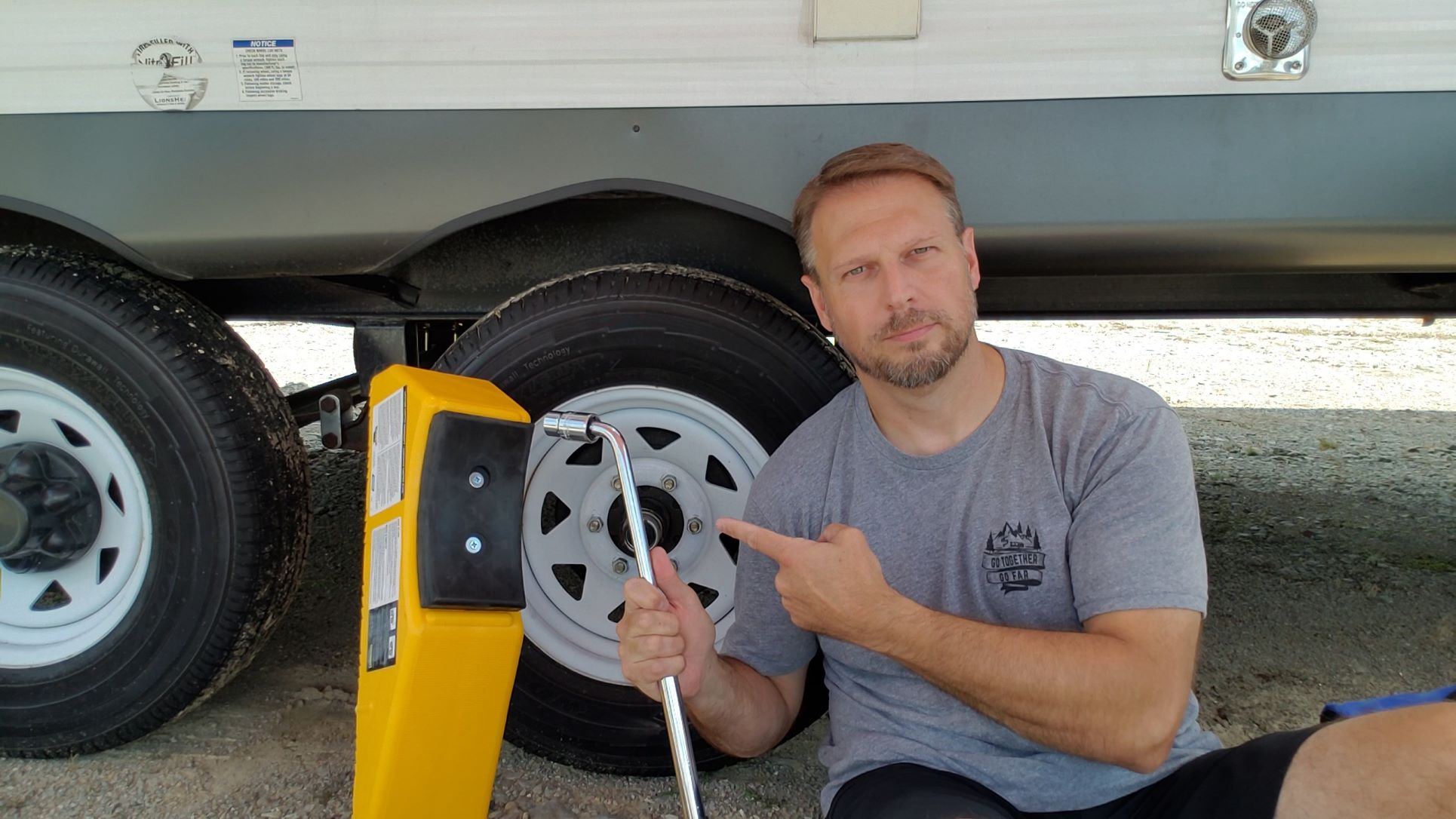Owning a trailer can make your life incredibly easier by allowing you to tow large objects, increasing your storage capacity, and allowing you to live a more nomadic lifestyle. Yet, if your current trailer sits too low to the ground, you’ll risk bottoming out every time you go over a speedbump or drive through hilly terrain.
If your trailer has torsion axles, installing a DEXTER Tandem Torflex torsion axle lift kit can give you an extra three inches of clearance, helping to keep your trailer from smacking the ground. You’ll need a jack and a socket wrench to install the lift kit to create the necessary torque.
If you’ve never installed a lift kit before, I’ll walk you through the step-by-step process of lifting your torsion axle trailer. I’ll also share some tips to make your life easier and fill you in on some information you should know before lifting your trailer, as it could affect how well it rides. So, if you’re ready to get started, let’s dive in!
Don’t forget to check out our Recommended RV Equipment list!
Understanding What a Torsion Axle Is
Before getting into the installation process, you must understand what a torsion axle is and how it functions. This will make the installation process much easier to understand. A torsion axle is a type of axle that uses a torsion bar—a long, thin, metal bar that connects the axle to the frame– to provide suspension for the trailer.
As the axle moves up and down, the torsion bar twists, which provides resistance and helps to absorb shocks. This helps keep the trailer from bouncing around too much and makes for a smoother ride. Torsion axles are typically found on light-duty trailers, such as utility trailers, boat trailers, and pop-up campers.
If you’re unsure if your trailer has torsion axles, you can check the owner’s manual or look at the axles themselves. Torsion axles typically have a smooth, round surface, while leaf spring axles have a series of raised ridges stacked in descending size.
Lifting Torsion Axles
If your trailer sits too low to the ground, you’ve probably noticed it scraping against bumps and sudden inclines in the road. While this is not only annoying, regularly bottoming out your trailer can damage the frame and anything you’re towing. Luckily, DEXTER makes a lift kit specifically for Torflex torsion axles.
By simply installing one of these kits, you can add an extra three inches of height to your trailer. The kit itself is pretty affordable, and you can install it by hand using these simple steps:
- Using a hydraulic jack, lift the trailer high enough that the tires sit no less than 3 inches above the ground. The lift kit will add an extra 3 inches of clearance, so you’ll need this amount of space or more to install the spacers properly.
- Remove all tires from the trailer.
- Position an axle jack in preparation to lower the axles. You will not have to drop the axles completely, but you will have to lower them enough to position the spacers in place.
- Loosen the bolts holding one side of the axle to the frame without removing them. You’ll work one side at a time, but the bolts must be loose enough that the axle can drop slightly. On the other side, remove the bolts completely.
- Slide the spacer between the mounting bracket and the frame with the open side facing outwards. Tighten two bolts into the back of the spacer with washers on the nut side only, followed by two bolts into the bottom of the spacer. Place washers on both the bolt and nut sides for the bottom bolts. Using a torque wrench, tighten the bolts to 150 lbs of torque.
- Repeat the process on the other side before moving on to the second axle.
- After installing spacers on both axles, replace the tires and lower your trailer back down to the ground. It should now sit roughly 3” higher than before.
We should point out that DEXTER’s torsion axle lift kit is not designed for trailers with 3” tall mounting brackets. With more clearance, you may want to upgrade your tires to a larger 15” variety to maximize the added lift.
Tips to Make Installation Easier
Although the installation process is pretty straightforward, it’s always nice to do things the easy way. Here are a few tips I can recommend to make your life easier and smooth out the set-up process:
- If you’re working alone, it’s helpful to use two jacks—one to support the trailer and one to support the axle. This will make it easier to lower the axle and slide the spacers into place.
- If your trailer has electric brakes, you’ll need to disconnect the wiring before lowering the axle. The best way to do this is to disconnect the negative battery terminal. This will ensure that the electrical system doesn’t accidentally engage the brakes while you’re working.
- When tightening the bolts, use a torque wrench to ensure that they’re properly tightened. Over-tightening the bolts can cause damage to the spacers, while under-tightening them can cause the spacers to come loose while you’re driving.
- If you have difficulty removing the bolts holding the axle to the frame, you can try spraying them with a penetrant like WD-40. Let the penetrant sit for a few minutes before you try to remove the bolts again.
- If you’re still having trouble, you can try heating the bolts with a torch. Be careful not to overheat them, as this can damage the threads.
Don’t hesitate to contact a professional if you still can’t get the spacers positioned between the axle and frame or are having trouble with other steps. Pretty much any mechanic can help you install a lift kit, and they’ll save you the headache of struggling with installation.
What to be Aware of Before Lifting a Trailer
While lifting your trailer will prevent it from bottoming out on speedbumps and hills, you’ll immediately notice a change in how it rides. You’ll shift the center of gravity when you lift the axles, changing how the trailer moves, especially on turns. Here’s what you should know:
- Increased sway and pivot – By shifting your trailer’s center of gravity upwards, it sways more easily than before. This can cause it to pivot differently and increase your likelihood of jackknifing your trailer on tight turns.
- Decreased fuel efficiency – Positioning your trailer higher into the air will create more wind resistance and drag, burdening your truck’s engine. Although the difference is relatively small, you may notice a slight decrease in fuel efficiency after lifting your trailer.
- Lift kits won’t fix broken axles – If your axles are banged up or sagging from wear and tear, simply installing a set of spacers isn’t going to solve the problem. If your axles are broken, take your trailer to a mechanic and have them appropriately fixed before you do any more damage.
- You may need new ramps – After lifting your trailer, you may find that the ramp sits at an odd angle. If it isn’t long enough, the angle could make it harder to wheel heavy machinery onto your trailer. If this is the case, I recommend changing out the old ramp with a new, longer ramp to make moving heavy objects easier.
- You may need to readjust the coupler – Depending on how much you lift your trailer, you may need to readjust the coupler. This is the part that attaches your trailer to your truck’s hitch. The best way to do this is to back your trailer up to a set of steps before locking it into place using the set screws.
Some of these disclaimers may make you hesitant to adjust your trailer. In my opinion, though, if you’re already bottoming out on the slightest incline, it’s best just to lift your trailer and deal with the consequences.
The more you drive it around, the more you’ll get used to the changes, and any other adjustments that need to be made can typically be done in a single afternoon.
The Bottom Line
If your trailer sits too low to the ground, lifting it is a great way to add extra clearance and prevent damage. By following the steps in this guide, you can install a DEXTER Tandem Torflex lift kit in no time. Just remember to keep the tips I shared in mind and take extra care when driving, as a lifted trailer will handle differently than a standard one.
If you’re struggling with any part of the installation process, don’t hesitate to take your trailer to a professional. They’ll be able to help you get your trailer lifted in no time so you can get back on the road.
Don’t forget to check out our Recommended RV Equipment list!
Get a FREE copy of the Go Together Go Far Travel Trailer Hookup and Disconnect Checklist when you sign up for the Go Together Go Far Newsletter!
Want to learn more about different types of RVs? Check out:
- Best Off-Road Camper Trailer Under $10,000
- Best Bunkhouse Travel Trailer Under 30 Feet
- Are Lance Travel Trailers Any Good?
- Do Rope Lights Deter Rodents?
- What Are the Best Names in the RV Industry?
- 3 Best Travel Trailers for Family of Four
- Blue Ox SwayPro Basics: Top Questions Answered
- Adding A Washer Dryer To Travel Trailer? What You Need To Know.
- Best Drone For Camping, Backpacking, and RVing: A Complete Guide to Drones for RVers
- Furniture and RVs – How To Get It Through the Door…
- How To Get Rid Of A Poop Pyramid In RV Black Tank
- Do You Know How Long To Keep Fresh Water In RV Tank Storage?
- What Is The Best Outdoor Security Camera System For Your RV?
- RV Bumper Mount Grills: 5 Best Options For Your RV Or Camper
- Best Electric Tankless Water Heater for Your RV. What You Need To Know
- Read Before You Buy! How to Find the Best Scooter for RV Camping
- 3 Best Travel Trailers for Family of Four
- Top RV Brands: What Are the Best Names in the RV Industry?
- Lance Campers: What Makes Them So Different?
- Best Bunkhouse Travel Trailer Under 30 Feet
- Best Off-Road Camper Trailer Under $10,000
- Best Weight Distribution Hitch With Sway Control For Travel Trailers in 2022
- What Are The Best Built Travel Trailers? Things To Consider.
- How Does An RV Refrigerator Work? A Quick Guide.
- Why Does My RV Carbon Monoxide Detector Keep Beeping? A Quick Guide.
- Where Is The Power Converter In My RV Or Travel Trailer
- What is the Best Generator for 50 Amp RV?
- Wireless RV Security Camera Systems: Is Solar Powered Security Without Wi-Fi An Option?
- Best Portable Air Conditioner for Camping for 2022
- How to Find the Best 3500 Watt Inverter Generator for RV Camping
- Best Propane Generator For Your RV: Read This Before You Buy!


